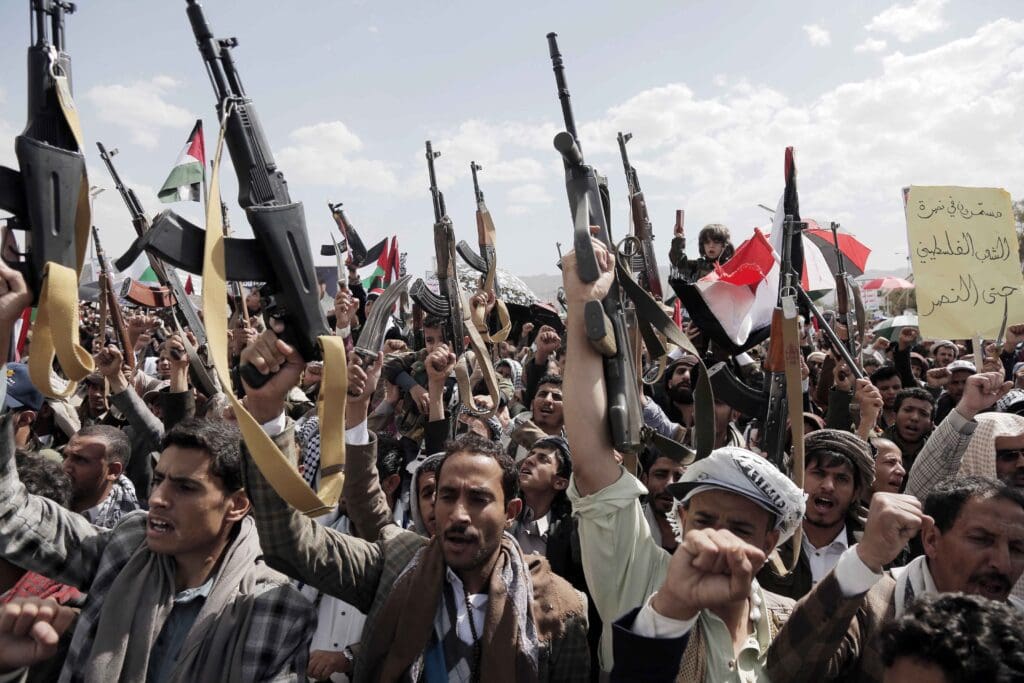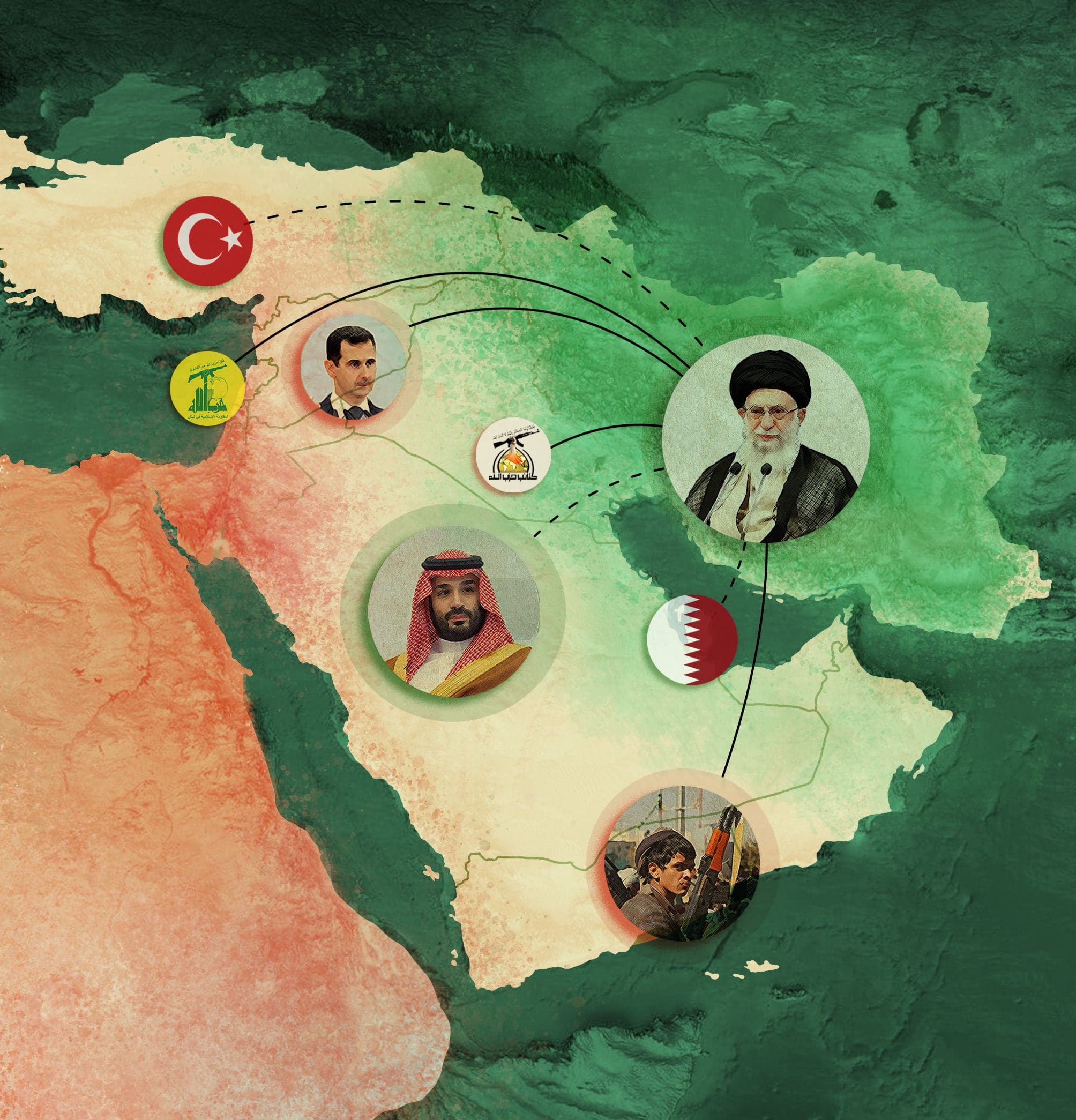
Iran’s Role in the Yemen War: Real Influence and Regional Gains
April 2024
Introduction
Over the past decade, Iran has emerged as a key regional player in Yemen supporting Ansar Allah (commonly known as the Houthis). In research and policy circles, there are three primary analyses of this relationship. The first exaggerates the extent of Iranian influence in Yemen, considering the Houthis as a regional proxy—a perspective supported by the internationally recognized government and its allies, namely the United States (U.S.) and Saudi Arabia.1 The second view, representing Iran and its supporters, regards the Houthis as an autonomous entity representing the Yemeni Republic—merely aligned with Iran on certain aims and ideological positions.2
The third view recognizes a complex relationship between Iran and the Houthis. The group has used Iranian missiles, unmanned aerial vehicles (UAVs), and other weapons “of Iranian origin.”3 Still, it is not clear whether the relationship is one of subordination or a partnership. Though similar interests do bring them together, other factors clarify the nature of the relationship, which began before the Houthi takeover of Sanaa and escalated after the Saudi-led Arab coalition launched Operation Decisive Storm in March 2015.4
Nevertheless, the extent of Iran’s influence over the war in Yemen remains a subject of debate.5 Despite the China-brokered Iran-Saudi reconciliation in March 2023, Iran has not made significant concessions on the Yemen file and the Houthi’s negotiating terms have not changed.6 While some analysts contend that the agreement could open prospects for peace in Yemen—suggesting the Houthis might make concessions under Iranian pressure—this seems unlikely in the short-term.7
To clarify Tehran’s role in Yemen, along with its local and regional impacts, this chapter will first examine Iranian foreign policy and motives in Yemen. The second section will discuss the relationship between Ansar Allah and Iran, questioning whether the Houthis are proxies or allies of Iran. And the third section will delineate the extent of Iran’s regional influence and impact on the Yemeni war.
Iran’s Foreign Policy and Motivations in Yemen
The pillars of Iran’s foreign policy consist of its active regional role,8 opposition to Israel and the West, and pursuit of an alternative regional order.9 The presence of weak central authorities and dissatisfied local actors has enabled Tehran to intervene regionally, as evident in 1980s Lebanon, Afghanistan, post-invasion Iraq, and post-Arab Spring Yemen.
Iranian support for non-Shia armed groups is motivated by their ideological alignment with the second pillar of Tehran’s foreign policy, namely opposition to Israel and the West. Yemen’s geostrategic location along one of the most important waterways in the world, the Bab al-Mandeb Strait, gives it outsize leverage over global shipping as a crucial part of this opposition. To cultivate influence in the country, Iran previously supported the armed Southern Movement (al-hirak al-janoubi) as a key component of its regional policy.10 Later on, Iran’s interests in Yemen aligned more with the Houthis than with the Southern Movement; importantly, the Houthi movement actively opposes the United States, unlike certain other Yemeni actors.11 Given this alignment, any increase in the Houthi’s power reinforces Iran’s regional influence. Moreover, cultivating ties with these groups has allowed Tehran to pursue its third foreign policy pillar, aiming to establish an alternative political order via the “Axis of Resistance.”
Historically, contrary to common assumptions, the relations between Iran and the Zaidi state in northern Yemen were extremely limited. Iran provided minimal support to Zaidi Imam Muhammad al-Badr during his war with the republicans in the 1960s,12 which concluded with the establishment of the Yemen Arab Republic. Founding figures of the Houthi movement, including Hussein Badr al-Din al-Houthi, studied in the post-revolution Islamic Republic, suggesting that they were influenced by Iranian revolutionary ideology.13
Since Hussein al-Houthi founded his movement in the mid-1990s until the start of the Houthis’ rebellion in 2004, there was no evidence suggesting that Iran provided any support to the group.14 The first limited military and financial support reportedly occurred in 2009, increasing gradually from there.15 Early on, Iran realized that overt support for the Houthis could escalate tensions, potentially culminating in direct confrontation with Saudi Arabia—a scenario Tehran sought to avoid. Nevertheless, the state maintained its marginal connection with the Houthis.
Iran and the Houthi Group: Proxies or Allies?
The debate surrounding the relationship between Iran and the Houthis is a recurring topic. Some view the group as Iran’s proxy, while others assert that it is an autonomous actor. This chapter argues that the relationship between Tehran and Ansar Allah is complex; their views and interests differ based on various religious, political, and historical factors. Instead of an Iranian proxy, it is an organized force pursuing its objectives through pragmatic policies. At the same time, Iran has taken advantage of the rise of the Houthis to gain influence in Yemen.
The origin of the Houthi movement differs from other militias aligned with Tehran. It was not established by the Islamic Revolutionary Guard Corps (IRGC) like Lebanon’s Hezbollah or certain Iraqi militias. The Houthis emerged in the late 1990s out of al-Shabab al-Mu’min (“The Believing Youth”)—a Zaidi revivalist movement in northern Yemen.16 Hussein Badr al-Din al-Houthi, through the Al-Haqq Party, seized control of the group in 1999.17
Moreover, the Houthis built on the historical legacy of the Zaidi state that governed northern Yemen for centuries until the 1962 September Revolution. The movement was born from Zaidi doctrines and political ideology,18 including a commitment to revolution against injustice. While rooted in Zaidi ideology, the Houthi movement is also a political one based on revolution against injustice and imperialism.19 Similarly, the Iranian revolutionary model—based on clerical political authority—influenced the Houthis ideologically. For instance, the founder of the group, Hussein al-Houthi, often praised Imam Khomeini’s resistance of imperialism and adopted slogans from the Iranian revolution.20 Ultimately, it is difficult to determine conclusively the degree of doctrinal affiliation between the Houthis and Iran.
As previously mentioned, Iranian support for the Houthis began around 2009, with subsequent years witnessing support in terms of weapons and expertise.21 The relationship expanded after the Houthis seized control of Sanaa in September 2014, marked by increased flights between Sanaa and Tehran.22 In March 2015, the-Saudi Arabia-led coalition (SLC), fearing Iran’s control over the Bab el-Mandeb Strait,23 announced the start of Operation Decisive Storm, intending to drive the Houthis out of Aden and Dhale.24 The southern forces that fought against the Houthis in Dhale included units affiliated with the southern leader Ali Salem al-Beidh, who had received training and support from Iran earlier,25 before their relationship soured following the Houthi takeover of Sanaa.26 This leads to the conclusion that Iran sought an ally to secure its interests in Yemen, regardless of its ideology.
The Houthi movement has practiced a similar pragmatism in its political and military ascent. It originated with the intent of preserving the Zaidi minority, engaging in six rounds of conflict to achieve this objective.27 In 2011, it presented itself as an advocate for the people of Saada; then, as a representative of northern tribes; and finally, after Operation Decisive Storm, as an official authority representing the Yemeni people.28
After the launch of Operation Decisive Storm, Iran was the only power to recognize the Houthis by establishing formal diplomatic relations and providing advanced weapons, drones, and missile systems.29 Simultaneously, the Houthis built their own military and economic capacity by the capture of state institutions in northern Yemen. Together, this elevated the Houthi group to a formidable player in the region, allowing it to strike targets in Saudi Arabia and the UAE, shifting the regional balance of power. However, the Saudi-Iran rapprochement has not meaningfully reduced Tehran’s support for the Houthis. Nevertheless, shifting geopolitical developments could alter Tehran’s relationship with the Houthis.
Iran’s Involvement in the Yemen War and Regional Gains
Iran has never officially acknowledged its involvement in the Yemeni war; it denies supporting the Houthis despite international reports confirming such support.30 Operation Decisive Storm altered the dynamics in Yemen. Saudi Arabia sought to reduce Iran’s influence and contain the Houthis, but the war escalated, leading to a severe humanitarian crisis and the deaths of tens of thousands of civilians.31 This later led some to blame Saudi Arabia for failing to prevent the Houthis from aligning with Tehran.
Thus, the war pushed the Houthis further into Iran’s embrace, deepening hostilities with Saudi Arabia. In 2018, Russia vetoed a United Nations (UN) resolution to condemn Iran for violating the arms embargo on the Houthis.32 Indicating Yemen’s growing importance to Tehran, Hassan Irlu,33 who is reportedly an IRGC officer, was appointed as Iranian ambassador to Sanaa in 2020.34
By securing an active partner in Yemen, Iran has increased its regional influence without incurring significant financial shortfalls, unlike Saudi Arabia’s loss of millions of dollars in this conflict.35 Iran has supplied the Houthis with drones and cruise missiles,36 enabling them to threaten ships passing through the Bab el-Mandeb Strait, thereby exerting international pressure and influencing global trade.37 These threats persist despite the naval blockade imposed on the Houthis. In fact, the approximate range of the Houthi anti-ship missiles may have increased compared to what it was in 2017, as indicated in figure 1 below.
Figure 1: A new threat in Yemen

Source: https://worldview.stratfor.com/article/new-threat-red-sea-shipping.38
The Houthis’ maritime capabilities serve Iran’s interests in the Red Sea—an area crucial for global trade and regional security. Approximately nine percent of the world’s petroleum traded by sea routes passes through the sea.39 In 2018, a senior officer in the IRGC, Nasser Shabani, admitted that his organization “had instructed the Houthis to attack two Saudi oil tankers in the Red Sea, west of the strategic port of [Hodeida].”40 This led Saudi Arabia to temporarily suspend oil shipments through the passage.41
While Iran may not be able to end the Yemen war, it can contribute to de-escalation. The Yemen conflict, rooted in past civil wars, revolves around local factions vying for control. It is not a proxy or sectarian war, as often portrayed. While the intense regional competition between Iran and Saudi Arabia fuels the internal conflict, it is not the primary driver. Therefore, the main causes of the Yemen conflict are local, with regional interventions aimed at maintaining the balance of local power to preserve Saudi influence. Yemen holds primary importance for Saudi Arabia while it is secondary for Iran, as a means to augment its regional dominance.
Conclusion
There is no doubt that Iran has succeeded in gaining influence with Ansar Allah. This leverage has reinforced Tehran’s regional standing and demonstrated success in the government’s foreign policy. However, it is important to avoid exaggerating the sectarian and proxy dynamics of the conflict, oversimplifying the relationship between Iran and the Houthis, and ignoring local drivers of the war.
Instead, the Houthis have motives distinct from Iran and local relationships that give them an advantage over other Yemeni parties. Iranian support affords them additional strategic capabilities, enabling the group to threaten neighboring countries and maritime navigation. This has served both Iran’s regional objectives and the Houthis’ local goals.
Please note that this dossier was compiled before Iran’s drone and missile attack on Israel on April 13. The strike marked Tehran’s first direct attack on Israel, framed as a retaliation for the Israeli strike on the Iranian consulate in Damascus on April 1. This dossier provides insights into Iran and its policy thinking. The analysis does not reflect recent developments.
The opinions expressed in this chapter are those of the author and do not necessarily reflect the views of the Middle East Council on Global Affairs.
Endnotes
1 Farea Al-Muslimi, “Iran’s Role in Yemen Exaggerated, but Destructive,” The Century Foundation, May 19, 2017, https://tcf.org/content/report/irans-role-yemen-exaggerated-destructive/.
2 Ibid.
3 UN Panel of Experts on Yemen, transmitted by letter dated Jan. 26, 2018, established pursuant to Security Council Resolution 2140 (2014) addressed to the President of the Security Council, 1-329, U.N. Doc. S/2018/594 (Jan. 26, 2018), https://digitallibrary.un.org/record/1639536?ln=en&v=pdf#record-files-collapse-header.
4 Al-Muslimi, “Iran’s Role in Yemen.”
5 Ibid.
6 Heiko Wimmen et al., “Impact of the Saudi-Iranian Reconciliation on Middle East Conflicts,” International Crisis Group, April 19, 2023, https://www.crisisgroup.org/middle-east-north-africa/gulf-and-arabian-peninsula/iran-saudi-arabia/impact-saudi-iranian.
7 Ibid.
8 Aisha Al Saad, Determinants of Iranian Foreign Policy Toward the Gulf States in the Context of Iran Nuclear Negotiations (Doha, Qatar: Arab Center for Research and Policy Studies, 2018), 109.
9 Mahjoob Zweiri,‘Iran; muqarabat fi alsiyasat alkharijiat waldaakhilia [Iran: Approaches to Foreign and Domestic Policy] (Beirut: Arab Scientific Publishers, 2020), 32.
10 Al-Muslimi, “Iran’s Role in Yemen.”
11 Kali Robinson, Yemen’s Tragedy: War, Stalemate, and Suffering, Backgrounder (Washington, D.C.: Council on Foreign Relations, May 1, 2023), https://www.cfr.org/backgrounder/yemen-crisis.
12 Mohsen Milani, “Iran’s Game in Yemen: Why Tehran Isn’t to Blame for the Civil War,” Foreign Affairs, April 19, 2015, https://www.foreignaffairs.com/articles/iran/2015-04-19/irans-game-yemen.
13 Nadwa Al-Dawsari, The Ideological Underpinnings of the Houthis’ Red Sea Attacks, Analysis, (Washington, D.C.: Middle East Institute, January 22, 2024), https://www.mei.edu/publications/ideological-underpinnings-houthis-red-sea-attacks.
14 Adel al-Ahmadi, Al-Zahr wa-l-Hajar: at-tamarud al-shi’i fi-l-yaman wa-mawqi’ al-‘aqaliyat a-shi’iyya fi-l-sinariyu al-jadid [The Flower and the Stone: Shiite Rebellion in Yemen and the Position of Shiite Minorities in the New Scenario] (Sanaa, Yemen: Nashwan Alhemyari Center for Studies and Media, 2006), 127–183.
15 Kali Robinson, Iran’s Support of the Houthis: What to Know, Brief, (Washington, D.C.: Council on Foreign Relations, March 1, 2024), https://www.cfr.org/in-brief/irans-support-houthis-what-know#:~:text=By%20some%20experts’%20estimations%2C%20Iranian,the%20year%20they%20captured%20Sanaa..
16 Ahmed Nagi, Yemen’s Houthis Used Multiple Identities to Advance, (Beirut, Lebanon: Carnegie Middle East Center, March 19, 2019), https://carnegie-mec.org/2019/03/19/yemen-s-houthis-used-multiple-identities-to-advance-pub-78623.
17 Ibid.
18 Al-Dawsari, The Ideological Underpinnings.
19 Mohammed Almahfali and James Root, How Iran’s Islamic Revolution Does, and Does Not, Influence Houthi Rule in Northern Yemen, Analysis Paper, (Sanaa, Yemen: Sana’a Center For Strategic Studies, February 13, 2020), https://sanaacenter.org/publications/analysis/9050.
20 Ibid.
21 Robinson, Iran’s Support of the Houthis.
22 Mareike Transfeld, “Iran’s Small Hand in Yemen,” Sada (blog), February 14, 2017, https://carnegieendowment.org/sada/67988.
23 The Bab el-Mandeb Strait is an international chokepoint where many ships pass from Asia and Africa through the Suez Canal to the Mediterranean and Europe.
24 “Five Years Since Decisive Storm,” The Yemen Review, April 1, 2020, https://sanaacenter.org/publications/the-yemen-review/9518#Five_Years_Since_Decisive_Storm.
25 Al-Muslimi, “Iran’s Role in Yemen.”
26 Yasser Hassan, “Haqiqat al-‘alaqat bayn al-huthiiyn w-al-harak al-janubi” [The Truth about the Relationship between the Houthis and the Southern Movement], Al Jazeera, August 10, 2013.
27 Nagi, Yemen’s Houthis Used Multiple Identities.
28 Ibid.
29 Robinson, Iran’s Support of the Houthis.
30 Ibid.
31 Yemen Conflict Observatory (YCO) Database, “Yemen: Fatalities,” ACLED and Yemen Data Project, accessed March 19, 2024, https://acleddata.com/yemen-conflict-observatory/#1700477750819-86f9adce-838d.
32 “Rusiya tu’arqil qararan ‘umamiana yudin da’m ‘iran li-l-huthiiyn” [Russia Vetoes UN Resolution Condemning Iran’s Support for the Houthis], Al Jazeera, February 23, 2018, http://tinyurl.com/2zj55mbt.
33 Hassan Irlu passed away one year after his appointment, reportedly due to the coronavirus, as announced by the Iranian Ministry of Foreign Affairs. However, some doubt this and suggest his death might have occurred during one of the coalition airstrikes or that the Houthis had targeted him due to his increased influence.
34 “Marad ayrlu waffara fursa li-l-huthiiyn min ‘ajil al-mutalaba bi-rahilih” [Irloo’s Illness Provided an Opportunity for the Houthis to Demand His Departure], Yemen Future, December 21, 2021, https://yemenfuture.net/news/6033.
35 “Khasa’ir bi-l-milyarat … istinzaaf al-sa’udiyyaa fi ‘al-wahl al-yamani’” [Losses in the Billions … Saudi Arabia’s Attrition in the ‘Yemeni Mire’], Al Jazeera, September 30, 2019, https://www.aljazeera.net/politics/2019/9/30/%D8%A7%D9%84%D8%B3%D8%B9%D9%88%D8%AF%D9%8A%D8%A9-%D8%A7%D9%84%D9%8A%D9%85%D9%86-%D8%A7%D9%84%D8%AD%D9%88%D8%AB%D9%8A%D9%8A%D9%86-%D8%B5%D9%88%D8%A7%D8%B1%D9%8A%D8%AE.
36 Fabian Hinz, “Little and Large Missile Surprises in Sanaa and Tehran,” Military Balance (blog, International Institute for Strategic Studies), October 17, 2023, https://www.iiss.org/online-analysis/military-balance/2023/10/little-and-large-missile-surprises-in-sanaa-and-tehran/.
37 “The Bab El-Mandeb Strait Is a Strategic Route for Oil and Natural Gas Shipments,” U.S. Energy Information Administration, August 17, 2019, https://www.eia.gov/todayinenergy/detail.php?id=41073.
38 “A New Threat to Red Sea Shipping,” Rane, October 5, 2016, https://worldview.stratfor.com/article/new-threat-red-sea-shipping.
39 U.S. Energy Information Administration, “The Bab El-Mandeb Strait.”
40 Micky Aharonson, “Iranian-Russian Cooperation in Yemen,” Policy Paper, (Jerusalem: The Jerusalem Institute for Strategy and Security, March 1, 2019), https://jiss.org.il/en/aharonson-mansharof-iranian-russian-cooperation-in-yemen/.
41 Rania El Gamal, “Al-sa’udiyya ta’allaqa murur shahanaat an-naft ‘abr bab al-mandab ba’ad hajamaat li-l-huthiiyn” [Saudi Arabia Suspends the Passage of Oil Shipments through the Bab el-Mandeb Strait after Attacks by the Houthi Rebels], Reuters, July 26, 2018, https://www.reuters.com/article/idUSKBN1KG2DN/.


